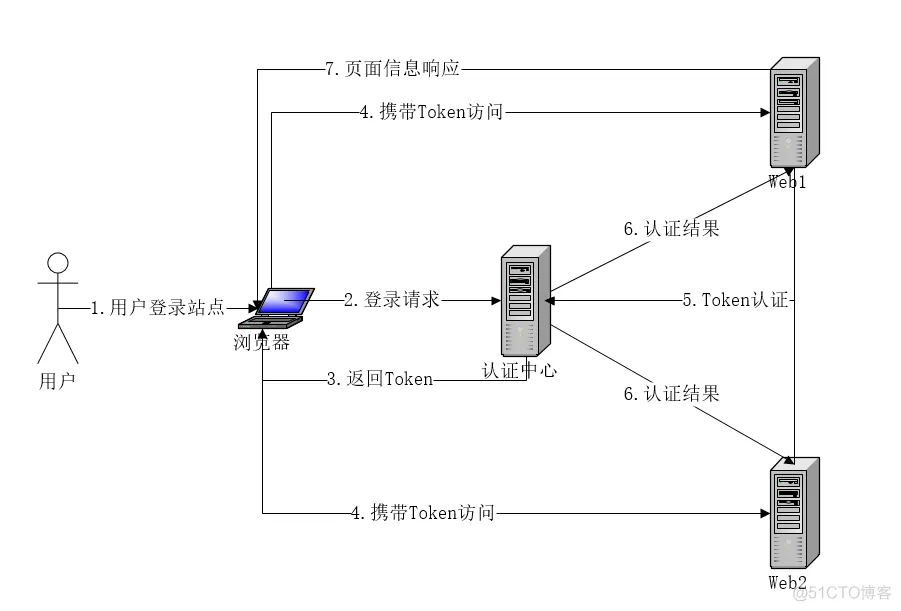SSO的系列还是以.Net Core作为实践例子与大家分享,SSO在Web方面复杂度分同域与跨域。本篇先分享同域的设计与实现,跨域将在下篇与大家分享。
如有需要调试demo的,可把SSO项目部署为域名http://sso.cg.com/,Web1项目部署为http://web1.cg.com,http://web2.cg.com,可以减少配置修改量
源码地址:https://github.com/SkyChenSky/Core.SSO

单点登录,全称为Single Sign On,在多个应用系统中,用户只需要登录一次就可以访问所有相互信任的应用系统。
它是一个解决方案,目的是为了整合企业内多个应用系统,仅由一组账号只需进行一次登录,就可被授权访问多个应用系统。

未登录状态访问业务Web应用会引导到认证中心。
用户在认证中心输入账号信息通过登录后,认证中心会根据用户信息生成一个具有安全性的token,将以任何方式持久化在浏览器。
此后访问其他Web应用的时候,必须携带此token进行访问,业务Web应用会通过本地认证或者转发认证而对token进行校验。
从上图可以简单的分析出三个关键点:
方式有多种:
可以通过Web框架对用户信息加密成Token。
Token编码方式也可以为JSON WEB TOKEN(JWT)
也可以是一段MD5,通过字典匹配保存在服务器用户信息与MD5值
浏览器存储有三种方式:
作为拥有会失效的会话状态,更因选择Cookie存储。那么Cookie的使用是可以在同域共享的,因此在实现SSO的时候复杂度又分为同域与跨域。
同域的共享比较简单,在应用设置Cookie的Domain属性进行设置,就可以完美的解决。
校验分两种情况:
原则上来讲,只要统一Token的产生和校验方式,无论授权与认证的在哪(认证系统或业务系统),也无论用户信息存储在哪(浏览器、服务器),其实都可以实现单点登录的效果。
此次使用.NET Core MVC框架,以Cookie认证通过业务应用自身认证的方式进行同父域的SSO实现。
1.会话状态分布在客户浏览器,避免大量用户同时在线对服务端内存容量的压力。
2.横向扩展良好性,可按需增减节点。
将以Core的Cookie认证进行实现,那么意味着每个应用对用户信息的加解密方式需要一致。
因此对AddCookie的设置属性DataProtectionProvider或者TicketDataFormat的加密方式进行重写实现。
public void ConfigureServices(IServiceCollection services) { services.AddMvc(); services.AddAuthentication(CookieAuthenticationDefaults.AuthenticationScheme) .AddCookie(options => { options.Cookie.Name = "Token"; options.Cookie.Domain = ".cg.com"; options.Cookie.HttpOnly = true; options.ExpireTimeSpan = TimeSpan.FromMinutes(30); options.LoginPath = "/Account/Login"; options.LogoutPath = "/Account/Logout"; options.SlidingExpiration = true; //options.DataProtectionProvider = DataProtectionProvider.Create(new DirectoryInfo(@"D:\sso\key")); options.TicketDataFormat = new TicketDataFormat(new AesDataProtector()); }); }1.2.3.4.5.6.7.8.9.10.11.12.13.14.15.16.17.public void ConfigureServices(IServiceCollection services) { services.AddMvc(); services.AddAuthentication(CookieAuthenticationDefaults.AuthenticationScheme) .AddCookie(options => { options.Cookie.Name = "Token"; options.Cookie.Domain = ".cg.com"; options.Events.OnRedirectToLogin = BuildRedirectToLogin; options.Events.OnSigningOut = BuildSigningOut; options.Cookie.HttpOnly = true; options.ExpireTimeSpan = TimeSpan.FromMinutes(30); options.LoginPath = "/Account/Login"; options.LogoutPath = "/Account/Logout"; options.SlidingExpiration = true; options.TicketDataFormat = new TicketDataFormat(new AesDataProtector()); }); }1.2.3.4.5.6.7.8.9.10.11.12.13.14.15.16.17.18.基于设计要点的“统一应用授权认证”这一点,两者的区别不大,ticket的加密方式统一使用了AES,都指定Cookie.Domain = ".cg.com",保证了Cookie同域共享,设置了HttpOnly避免XSS攻击。
两者区别在于:
options.Events.OnRedirectToLogin = BuildRedirectToLogin;options.Events.OnSigningOut = BuildSigningOut;1.2.这是为了让业务应用引导跳转到认证中心登录页面。OnRedirectToLogin是认证失败跳转。OnSigningOut是注销跳转。
/// <summary> /// 未登录下,引导跳转认证中心登录页面 /// </summary> /// <param name="context"></param> /// <returns></returns> private static Task BuildRedirectToLogin(RedirectContext<CookieAuthenticationOptions> context) { var currentUrl = new UriBuilder(context.RedirectUri); var returnUrl = new UriBuilder { Host = currentUrl.Host, Port = currentUrl.Port, Path = context.Request.Path }; var redirectUrl = new UriBuilder { Host = "sso.cg.com", Path = currentUrl.Path, Query = QueryString.Create(context.Options.ReturnUrlParameter, returnUrl.Uri.ToString()).Value }; context.Response.Redirect(redirectUrl.Uri.ToString()); return Task.CompletedTask; } /// <summary> /// 注销,引导跳转认证中心登录页面 /// </summary> /// <param name="context"></param> /// <returns></returns> private static Task BuildSigningOut(CookieSigningOutContext context) { var returnUrl = new UriBuilder { Host = context.Request.Host.Host, Port = context.Request.Host.Port ?? 80, }; var redirectUrl = new UriBuilder { Host = "sso.cg.com", Path = context.Options.LoginPath, Query = QueryString.Create(context.Options.ReturnUrlParameter, returnUrl.Uri.ToString()).Value }; context.Response.Redirect(redirectUrl.Uri.ToString()); return Task.CompletedTask; } }1.2.3.4.5.6.7.8.9.10.11.12.13.14.15.16.17.18.19.20.21.22.23.24.25.26.27.28.29.30.31.32.33.34.35.36.37.38.39.40.41.42.43.44.45.46.认证中心与业务应用两者的登录注册基本一致。
private async Task<IActionResult> SignIn(User user) { var claims = new List<Claim> { new Claim(JwtClaimTypes.Id,user.UserId), new Claim(JwtClaimTypes.Name,user.UserName), new Claim(JwtClaimTypes.NickName,user.RealName), }; var userPrincipal = new ClaimsPrincipal(new ClaimsIdentity(claims, "Basic")); var returnUrl = HttpContext.Request.Cookies[ReturnUrlKey]; await HttpContext.SignInAsync(userPrincipal, new AuthenticationProperties { IsPersistent = true, RedirectUri = returnUrl }); HttpContext.Response.Cookies.Delete(ReturnUrlKey); return Redirect(returnUrl ?? "/"); } private async Task SignOut() { await HttpContext.SignOutAsync(); }1.2.3.4.5.6.7.8.9.10.11.12.13.14.15.16.17.18.19.20.21.22.23.24.25.26.27.28.使用的是Cookie认证那么就是通过Microsoft.AspNetCore.Authentication.Cookies库的CookieAuthenticationHandler类的HandleSignInAsync方法进行处理的。
源码地址:https://github.com/aspnet/Security/blob/master/src/Microsoft.AspNetCore.Authentication.Cookies/CookieAuthenticationHandler.cs


protected async override Task HandleSignInAsync(ClaimsPrincipal user, AuthenticationProperties properties) { if (user == null) { throw new ArgumentNullException(nameof(user)); } properties = properties ?? new AuthenticationProperties(); _signInCalled = true; // Process the request cookie to initialize members like _sessionKey. await EnsureCookieTicket(); var cookieOptions = BuildCookieOptions(); var signInContext = new CookieSigningInContext( Context, Scheme, Options, user, properties, cookieOptions); DateTimeOffset issuedUtc; if (signInContext.Properties.IssuedUtc.HasValue) { issuedUtc = signInContext.Properties.IssuedUtc.Value; } else { issuedUtc = Clock.UtcNow; signInContext.Properties.IssuedUtc = issuedUtc; } if (!signInContext.Properties.ExpiresUtc.HasValue) { signInContext.Properties.ExpiresUtc = issuedUtc.Add(Options.ExpireTimeSpan); } await Events.SigningIn(signInContext); if (signInContext.Properties.IsPersistent) { var expiresUtc = signInContext.Properties.ExpiresUtc ?? issuedUtc.Add(Options.ExpireTimeSpan); signInContext.CookieOptions.Expires = expiresUtc.ToUniversalTime(); } var ticket = new AuthenticationTicket(signInContext.Principal, signInContext.Properties, signInContext.Scheme.Name); if (Options.SessionStore != null) { if (_sessionKey != null) { await Options.SessionStore.RemoveAsync(_sessionKey); } _sessionKey = await Options.SessionStore.StoreAsync(ticket); var principal = new ClaimsPrincipal( new ClaimsIdentity( new[] { new Claim(SessionIdClaim, _sessionKey, ClaimValueTypes.String, Options.ClaimsIssuer) }, Options.ClaimsIssuer)); ticket = new AuthenticationTicket(principal, null, Scheme.Name); } var cookieValue = Options.TicketDataFormat.Protect(ticket, GetTlsTokenBinding()); Options.CookieManager.AppendResponseCookie( Context, Options.Cookie.Name, cookieValue, signInContext.CookieOptions); var signedInContext = new CookieSignedInContext( Context, Scheme, signInContext.Principal, signInContext.Properties, Options); await Events.SignedIn(signedInContext); // Only redirect on the login path var shouldRedirect = Options.LoginPath.HasValue && OriginalPath == Options.LoginPath; await ApplyHeaders(shouldRedirect, signedInContext.Properties); Logger.SignedIn(Scheme.Name); }1.2.3.4.5.6.7.8.9.10.11.12.13.14.15.16.17.18.19.20.21.22.23.24.25.26.27.28.29.30.31.32.33.34.35.36.37.38.39.40.41.42.43.44.45.46.47.48.49.50.51.52.53.54.55.56.57.58.59.60.61.62.63.64.65.66.67.68.69.70.71.72.73.74.75.76.77.78.79.80.81.82.83.84.85.86.View Code
从源码我们可以分析出流程:
根据ClaimsPrincipal的用户信息序列化后通过加密方式进行加密获得ticket。(默认加密方式是的KeyRingBasedDataProtecto。源码地址:https://github.com/aspnet/DataProtection)
再通过之前的初始化好的CookieOption再AppendResponseCookie方法进行设置Cookie
最后通过Events.RedirectToReturnUrl进行重定向到ReturnUrl。
两种设置方式
如果做了集群可以设置到共享文件夹,在第一个启动的应用则会创建如下图的文件
options.DataProtectionProvider = DataProtectionProvider.Create(new DirectoryInfo(@"D:\sso\key"));1.
重写数据加密方式,本次demo使用了是AES.
options.TicketDataFormat = new TicketDataFormat(new AesDataProtector());1.internal class AesDataProtector : IDataProtector { private const string Key = "!@#13487"; public IDataProtector CreateProtector(string purpose) { return this; } public byte[] Protect(byte[] plaintext) { return AESHelper.Encrypt(plaintext, Key); } public byte[] Unprotect(byte[] protectedData) { return AESHelper.Decrypt(protectedData, Key); } }1.2.3.4.5.6.7.8.9.10.11.12.13.14.15.16.17.18.19.以上为.NET Core MVC的同域SSO实现思路与细节 。因编写demo的原因代码复用率并不好,冗余代码比较多,大家可以根据情况进行抽离封装。下篇会继续分享跨域SSO的实现。如果对本篇有任何建议与疑问,可以在下方评论反馈给我。
免责声明:本文系网络转载或改编,未找到原创作者,版权归原作者所有。如涉及版权,请联系删